The Dos and Don’ts of Initiating Contact Via Text
With your in-person first impression, you’ve got a bunch of tools to demonstrate the 3 elements of charisma — Presence, Warmth, and Power. With a text, you’re stuck with a static medium — somehow you’ve got to find a way to express those elements within the confines of the characters on a screen. It’s a challenge, but a very doable one. All you’ve got to do is follow these dos and don’ts Ansari and Klinenberg gleaned from their research:
Don’t:
Send a generic “Hey” text. “Hey,” “Heyyy,” “Wassup,” and “Watcha doin?” are as common as dirt, and clutter people’s phones across the land. They show no personality or thought, and are thus more likely to be ignored. They’re also terrible conversation initiators; what’s a good response to “Hey” besides sending one in return? Heyyy-ing inhibits the ball before it even gets rolling.
Use misspelled words/poor grammar. It may seem like a superficial, trivial thing, especially on a medium that’s meant for abbreviated, casual conversation, but Aziz found that poor spelling and grammar actually had a big effect on women’s perception of those texting them. Even if it happens on a subconscious level, you just come off as less mature and intelligent when you text things like, “Wanna go see the new Salvador Deli exhibit sum time?” Poor punctuation choices — like too many !!!! — is inadvisable as well.
Engage in endless banter. It’s fine to trade some pleasantries back and forth before asking for a date or telling her you’ll call later, but don’t let it drag on and on because you’re too scared to pull the trigger. “How’s your morning going?” “Good, just digging into a bowl of Lucky Charms.” “Cool. I love Lucky Charms, but I really just like the marshmallows. LOL.” This kind of banal banter continues for days, even weeks, and often fades away without the pair ever meeting up again.
Get caught up in an endless back and forth about scheduling. The bane of socializing in modern life — among friends and lovers alike — is trying to schedule a time to get together. You suggest a time for the date; they’re unavailable for that time and promise to get back to you with a better one. When they do, you’re busy that day. And on it goes for days, perhaps weeks! An endless back and forth about scheduling can also confuse the initiator as to whether or not a gal is really busy, or simply trying to turn him down “nicely.”
Repeatedly text multiple messages back to a single reply and/or send long messages in reply to short ones. You should see about the same amount of blue and green bubbles on your screen, both in the number of messages, and in their length. You don’t want to come off as overly eager and excited in a way that doesn’t match your recipient’s level of enthusiasm.
Leave it unclear as to whether you’re asking for a date or to simply hang out. One of the biggest pet peeves amongst the women in Ansari’s focus groups was when guys left it unclear as to whether they were extending an invitation to hang out or for a real date. Everyone likes to be able to set accurate expectations for what’s in store.
Don’t know the difference between a date and hanging out? Remember the 3 P’s: a real date is Planned out, Paired off (just the two of you), and Paid for.
Text back right away. It looks desperate. More on timing below.
Do:
Refer back to the previous in-person interaction. Show that you were listening when you talked face-to-face and that your interaction left a memorable impact. “I’m still laughing about the fact that the guy took a chicken finger off your plate and walked away! Classic.” “Thanks a ton for recommending I pick up Brandon Flowers’ new album. It’s so much better than I was expecting. What’s your favorite song on it?”
Extend a firm invitation to something specific at a specific time. Cut short the scheduling back-and-forth, the endless banal banter, and the questions over whether you’re going to be hanging out or dating in one fell swoop by sending a clear, direct invitation that explains what, when, and where. “I’d love to take you out to dinner at the Spicy Burrito on Friday. Let me know if you’re free.” Or even, “I’d love to take you on date. Friday, 7 pm at the Spicy Burrito. Let me know if you’re game.” In a time of wish-washy, pussy-footed texts, being confident and straightforward can surprisingly work wonders.
Now, you can certainly suggest a single date/time as in the above examples, but if she’s not available, that can lead to the initiation of a long scheduling exchange. I would recommend providing two options if possible: “I’d love to take you to dinner on Friday or Saturday. Which night would work best?” Not only does this give her choices, but it turns a yes/no question into a yes/yes one.
Texting and the Brad Pitt Rule
What should you do if you ask a woman out via text and she says she’s busy on the day(s) you propose? Should you ask again? The classic Brad Pitt rule kicks in here — but with a texting addendum. The Brad Pitt rule says that if a woman is interested in you, if she can’t accept a date at the time you propose, she’ll counter with an alternative; if she doesn’t, she’s not interested.
With a text though, I feel women may be less likely to do this. On the phone there’s more pressure to fill a gap in the moment; with texting it’s easier to let a message just sit there. What I mean is, you text, “How about dinner on Friday or Saturday?” She says: “Oh darn, I’m busy both days.” … Now who’s going to make the next move?
Responding with, “How about next weekend then?” sounds a little desperate, so text something like: “Ah, too bad. I’ll hit you up another time.” Then, you wait a week or so and ask again. If she’s still busy, and still doesn’t propose an alternative time, then she’s probably not interested.
In short, when applying the Brad Pitt rule to texting, ask twice rather than once before cutting your losses.
Use humor. Trying to be funny is chancy, because she might misinterpret your quip. But it’s usually worth an attempt if you think you’ve got something LOL-inducing to say.
Wait to respond. Yeah, yeah, yeah — nobody likes to play games, and can’t we all just be upfront and genuine and not be afraid to show our (over)eagerness? It’s a nice sentiment, surely, but it ignores the psychological/neurological reality of how our brains work.
Scientists have found that when they put rats (whose brains are surprisingly like ours) in a cage and allow them to receive a reward by pressing a lever, when the rewards come consistently — every time the lever is pressed — the rats start out eager and excited, but then lose interest and slow down their lever pushing. In contrast, when the lever-pushing only results in a reward some of the time, the rats get amped up and push the lever like crazy.
In another study, this time on human females, social psychologists showed college coeds the Facebook profiles of male students and were told that these men had already seen and rated the women’s own profiles. The female students were shown one set of men’s profiles they were told had rated them as average, one set they were told had liked them the best, and one set where the men had either rated them as average or best — the actual rating was withheld from the participants. Then it was the women’s turn to rate the men. Unsurprisingly, the women said they were more attracted to the men who had liked them best than those who had rated them as average; we like those who like us. But interestingly, they were most attracted to the set of men whose interest in them was uncertain. The women ended up thinking about those “in-limbo” men the most as well.
A similar principle undergirds both the rat and Facebook examples: uncertainty creates excitement, interest, and attraction. Waiting, anticipation, wonder — these feelings and behaviors boost dopamine in the human brain, driving you to want to know how an unresolved outcome will turn out. Uncertainty also simply makes you think about something, or someone, and the more you think about that person, the more attracted you feel to them; your brain thinks, “Well, if they’re stuck in my head like this, I must be interested.” Conversely, when something becomes completely predictable, our brains adapt to it, spend less mental energy on it, and thus find it less interesting.
All of this is to say: it really is effective and attraction-building to wait to respond to someone’s text messages. Lightning fast replies can be read as desperate (he’s just waiting by his phone), and predictability dulls attraction; staggered responses, on the other hand, build anticipation and interest.
But just how long do you wait? Aziz found a wide variety of responses in his interviews — everything from 1.25-5X as long as it took for the woman to respond to you. Ultimately, it probably doesn’t matter exactly how long you wait, within reason. Everyone knows that most people check their phone at least semi-regularly, so waiting a day or more will strain credulity. 2X as long as it took them to respond to you is probably about right. Finally, I think it makes the most sense to wait when responding to her initial texts, but to pick up the pace once you start hashing out the time/date to prevent the scheduling phase of the conversation from dragging on and on.
Putting It All Together
So how do you incorporate the above dos and don’ts into one charming, effective first text? Here are some examples:
Initiating contact via text as a prelude to calling for a date:
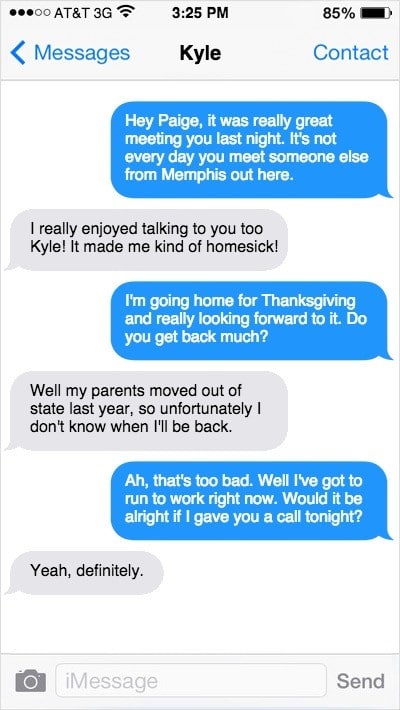
Kyle gives Paige a ring that night, exchanges some pleasantries, and then says, “You know we were talking this morning about being homesick for Memphis. I’d love to take you out to Elmer’s for dinner on Friday – it’s the best BBQ in town and really makes you feel like you’re back in Tennessee.”
Initiating contact via text to ask for a date:

If you’re feeling more confident, say something like, “Which night works best for you?” rather than, “Let me know if you’re available.”
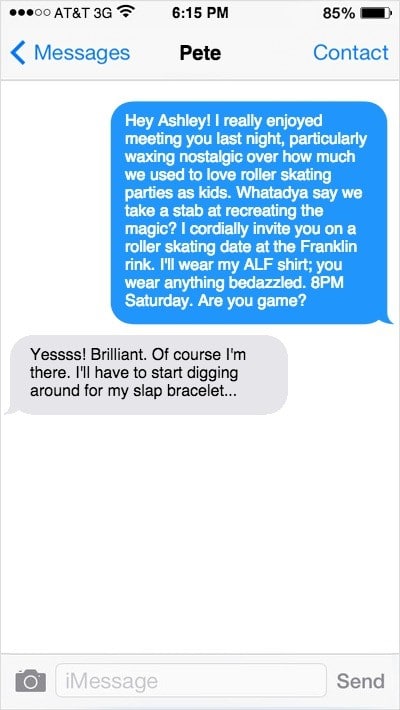
Directness? Check. Clear it’s a date? Check. A little humor? Check. It also incorporates another of Ansari’s recommendations: get more creative with your dates!
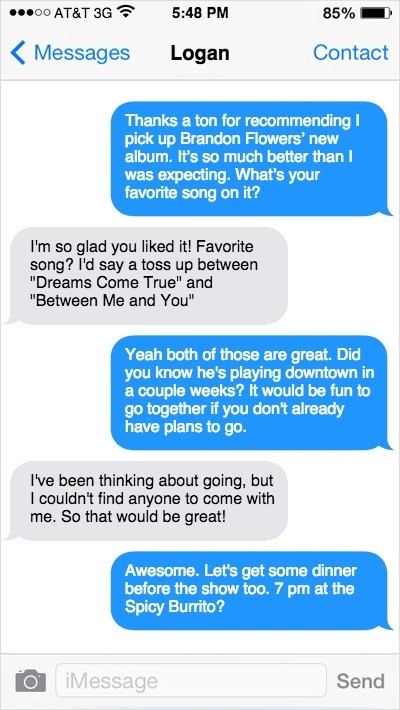
Whether it’s actually a date or not might be a little unclear with just an invite to go together to the show; dinner beforehand makes it clearer that it’s a date.
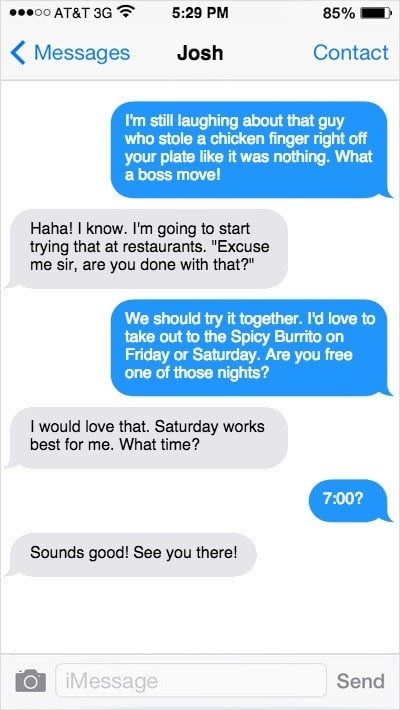
If you start off with a callback that’s not directly connected to your ask, try to use one that might naturally lead into asking for the date.
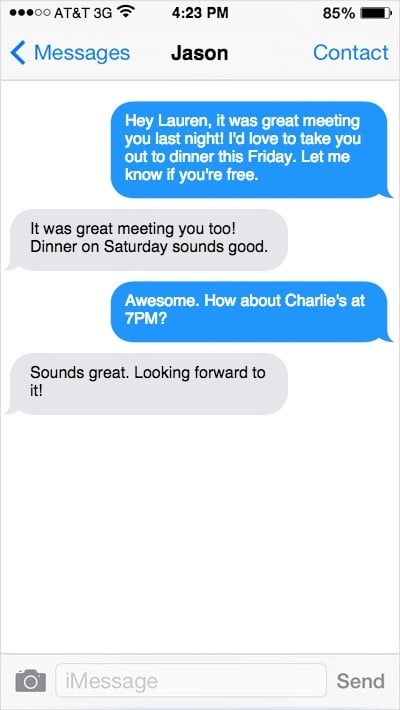
If you can’t think of a natural callback to your last in-person interaction, just a simple, direct message works fine and dandy.
Conclusion
To charmingly, effectively initiate contact with a woman via text, simply look to incorporate the 3 elements of charisma into your first message:
- Presence: Refer back to your last in-person interaction, so she knows you were listening when you met and that the meeting was memorable.
- Warmth: Send a personal rather than generic text; let her know how much you enjoyed meeting her; use humor.
- Power: Send the same number/length of messages as she does; ask directly for the date; wait to respond.
Be yourself, but double check that you’ve got everything spelled correctly and that your message is likely to be interpreted favorably; you want to be thoughtful, without overthinking things.
Ultimately, you simply want to put your best foot forward — texting is your second chance to make a good first impression, so make the most of it!
0 Comments